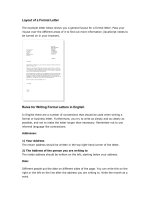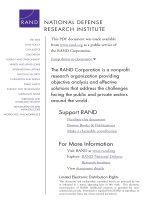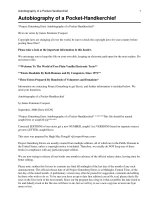Slides calculate probability of a given outcome
Bạn đang xem bản rút gọn của tài liệu. Xem và tải ngay bản đầy đủ của tài liệu tại đây (516.55 KB, 44 trang )
Calculate Probability of a Given
Outcome
Principles of Cost Analysis and
Management
© Dale R. Geiger 2011
1
The Dice Game
• Divide the students into equal groups
• Each group receives a pair of dice
• Students will each roll the dice five times,
keeping track of the total of each roll
• There will be a prize for highest individual
score and lowest individual score.
• There will be a prize for the group that finishes
the task first
© Dale R. Geiger 2011
2
Terminal Learning Objective
• Action: Calculate probability of a given outcome
• Condition: You are a cost advisor technician with
access to all regulations/course handouts, and
awareness of Operational Environment
(OE)/Contemporary Operational Environment
(COE) variables and actors.
• Standard: With at least 80% accuracy:
• Identify and enter relevant report data into macro
enabled templates to solve Probability equations
© Dale R. Geiger 2011
3
What is Probability?
• Probability is the likelihood or chance of a particular
outcome in relation to all possible outcomes
• Implies a division or ratio relationship:
Occurrence of Particular Outcome
Occurrence of All Outcomes
• Defining all possible outcomes in real-life scenarios
can be difficult, if not impossible
• To help us understand the concept of probability we
use simple examples with easily determined outcomes
© Dale R. Geiger 2011
4
What is Probability?
• The probability of an outcome must be a
number between 0 and 1 (inclusive)
• Probabilities are frequently stated as
percentages
• Probability of an impossible event is 0 or 0%
• Probability of an absolutely certain event is 1
or 100%
© Dale R. Geiger 2011
5
What is Probability?
• Example: What are the possible outcomes
when flipping a single coin?
•
•
•
•
Heads
-orTails
What is the chance or probability of Heads?
Heads is one of only two possible outcomes
The probability is 1/2 or 50% (with a fair coin)
Probability of Tails is also 50%
© Dale R. Geiger 2011
6
What is Probability?
• The sum of the individual probabilities of all
possible outcomes must equal 100%
• Probability of all possible coin-flip outcomes:
Heads
50%
Tails
50%
100%
© Dale R. Geiger 2011
7
Defining Outcomes
• Using two different coins, what are the
possible outcomes?
1.
2.
3.
4.
Two Heads
Two Tails
One Head and one Tail
One Tail and one Head
© Dale R. Geiger 2011
8
Defining Outcomes
• What is the probability of each outcome?
Outcome
Possible Ways to Achieve
Outcome
/Total
= Probability%
2 Heads
1
/4
= 25%
2 Tails
1
/4
= 25%
1 Head-1 Tail*
2
/4
= 50%
Total
4
/4
= 100%
*The combination may be 1 head-1 tail or 1 tail-1 head
© Dale R. Geiger 2011
9
Check on Learning
• What is the probability of an impossible
event?
• The sum of the probabilities of all possible
outcomes must be equal to?
© Dale R. Geiger 2011
10
The Dice Game
• What are the possible outcomes for the total of
both dice when rolling a pair of dice?
• Look at the results of the game to see what
different outcomes occurred
• It is possible to roll any of the following totals:
• 2, 3, 4, 5, 6, 7, 8, 9, 10, 11, or 12
• How many of each outcome actually occurred?
• How many in proportion to the total number of
rolls?
© Dale R. Geiger 2011
11
The Dice Game
Outcome
Possible Ways to Achieve
Number of Ways
Probability
2
1-1
1
1/36 or 2.8%
3
1-2, 2-1
2
2/36 or 5.6%
4
1-3, 2-2, 3-1
3
3/36 or 8.3%
5
1-4, 2-3, 3-2, 4-1
4
4/36 or 11.1%
6
1-5, 2-4, 3-3, 4-2, 5-1
5
5/36 or 13.9%
7
1-6, 2-5, 3-4, 4-3, 5-2, 6-1
6
6/36 or 16.7%
8
2-6, 3-5, 4-4, 5-3, 6-2
5
5/36 or 13.9%
9
3-6, 4-5, 5-4, 6-3
4
4/36 or 11.1%
10
4-6, 5-5, 6-4
3
3/36 or 8.3%
11
5-6, 6-5
2
2/36 or 5.6%
12
6-6
1
1/36 or 2.8%
Total
36
36/36 or 100%
© Dale R. Geiger 2011
12
Calculating Probability
1. Define all possible or relevant outcomes
2. Determine number of ways of achieving the particular
outcome
3. Determine total number of ways of achieving all possible or
relevant outcomes
4. Divide the number of ways of achieving the particular
outcome by the total ways of achieving all possible or
relevant outcomes
5. Probability =
Number of ways of achieving the particular outcome
Total number of ways of achieving all outcomes
© Dale R. Geiger 2011
13
Practice Problems
• When rolling a pair of dice, what is the
probability of rolling a total divisible by 5?
• Of all of the possible outcomes (2-12), which
ones are divisible by 5?
• How many ways of achieving each of those?
© Dale R. Geiger 2011
14
Practice Problems
• When rolling a pair of dice, what is the
probability of an even numbered total?
• Of all of the possible outcomes (2-12), which
ones are even?
• How many ways of achieving each of those?
© Dale R. Geiger 2011
15
Practice Problems
• When rolling a pair of dice, what is the
probability of a total divisible by 4? By 3?
• How would you approach this problem?
© Dale R. Geiger 2011
16
Practice Problems
• The bag of candy has 20 red candies, 10
yellow and 5 green. You reach in and take
one. What is the probability of getting a green
one? A red? A yellow?
• What are the possible outcomes?
• How many ways to achieve each outcome?
© Dale R. Geiger 2011
17
Check on Learning
• What is the first step in calculating
probability?
• What is the formula for calculating
probability?
© Dale R. Geiger 2011
18
Probability of Negative Outcome
• It may not be relevant to define the probabilities of all
possible outcomes
• What may be relevant is to define two possible
outcomes:
• Positive – a particular outcome
• Negative – all other outcomes
• If the probability of one is known, the other can be
calculated
• Probability of Positive = P
• Probability of Negative = 100% - P
© Dale R. Geiger 2011
19
Probability of Negative Outcome
• Example: When tossing two coins, what is the
probability of at least one Head?
• Positive outcome = at least one Head
• Negative outcome = no Heads
© Dale R. Geiger 2011
20
Probability of Negative Outcome
• What are the possible ways to achieve a
positive outcome?
• Three ways: Head-Head, Head-Tail, Tail-Head
• What are the possible ways to achieve a
negative outcome?
• One way: Tail-Tail
• Probability of at least one Head is 3/4 or 75%
• Probability of no Heads is 1/4 or 25%
© Dale R. Geiger 2011
21
Practice Problems
• When rolling a pair of dice, what is the
probability of NOT rolling a total of 6?
• Of NOT rolling a total of 7?
• What is the probability of NOT rolling a
number divisible by 5?
© Dale R. Geiger 2011
22
Practice Problems
• The probability of passing a certain class is
known to be 80%. What is the probability of
NOT passing?
© Dale R. Geiger 2011
23
Check on Learning
• How would you express the probability of NOT
being struck by lightning?
• What is the probability of NOT rolling a 2
when rolling two dice?
© Dale R. Geiger 2011
24
Independent Scenarios
• The probability that two independent outcomes
will BOTH occur is equal to the product of both
outcomes
• Since both probabilities are less than 100%, the
probability of BOTH will be less than the
probability of either one alone
• Examples:
80% * 60% = 48%
½*½=¼
© Dale R. Geiger 2011
25









